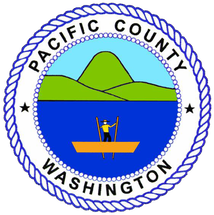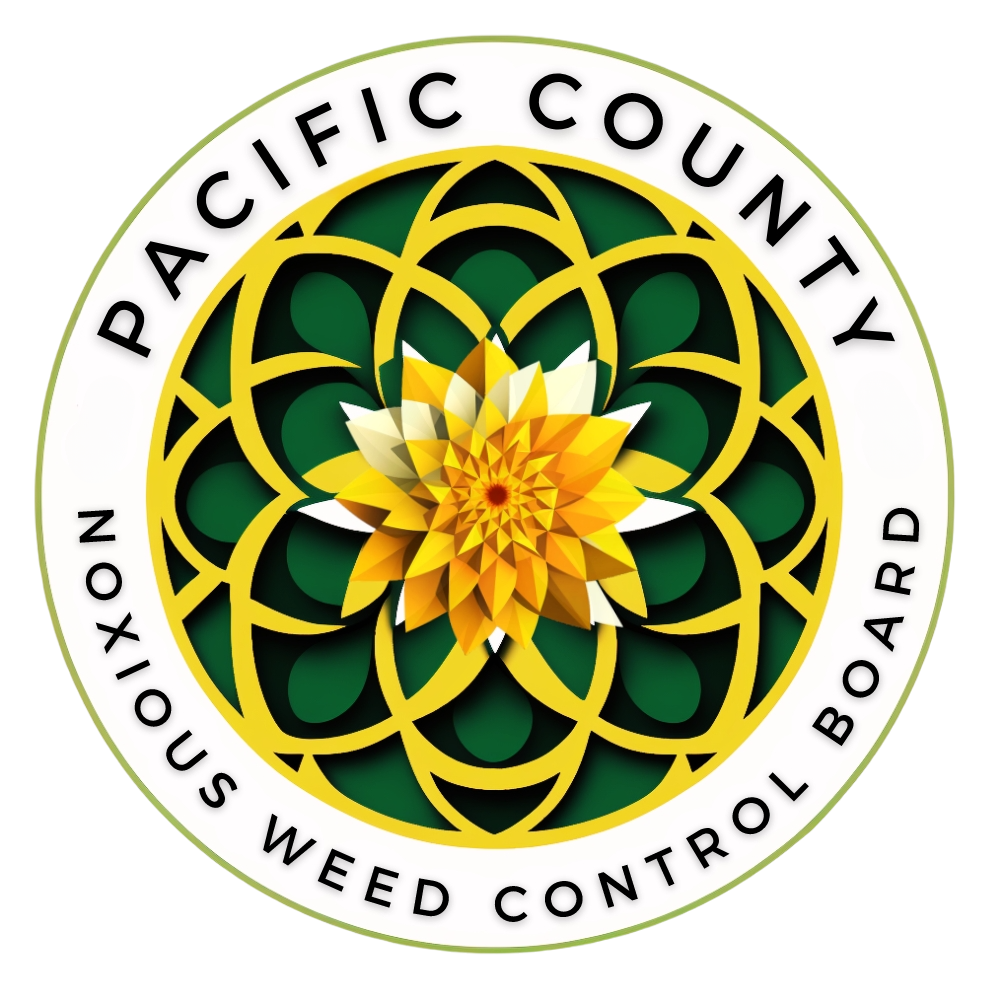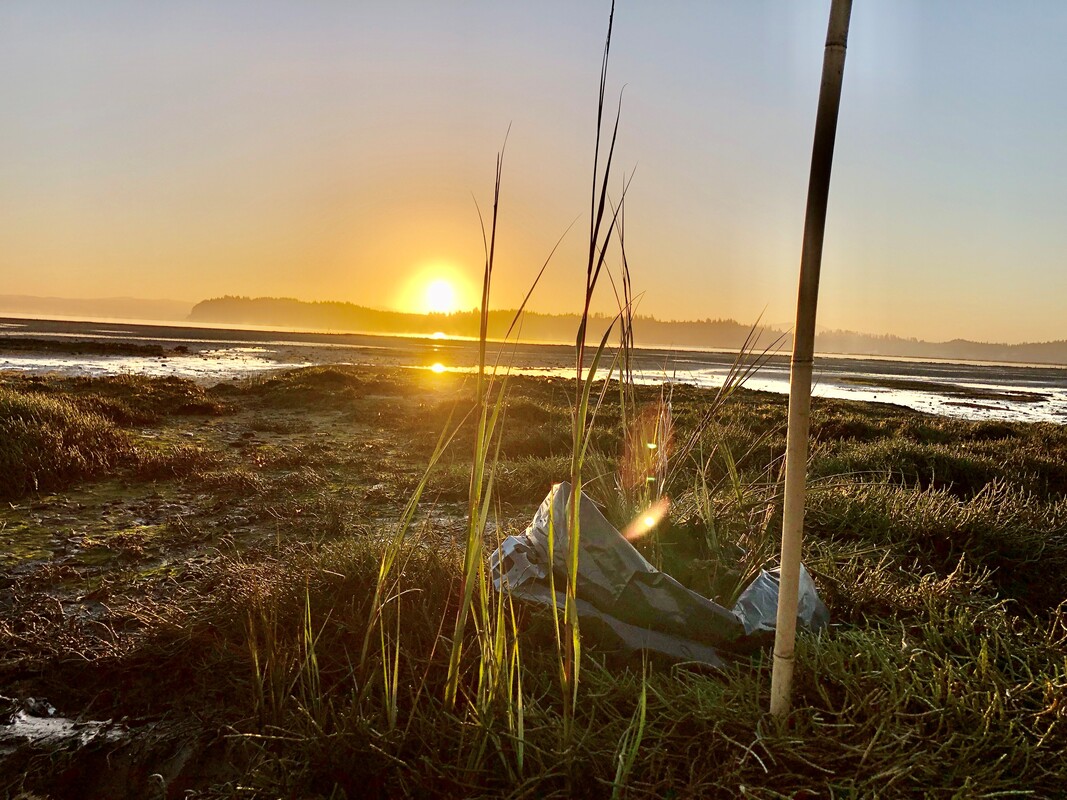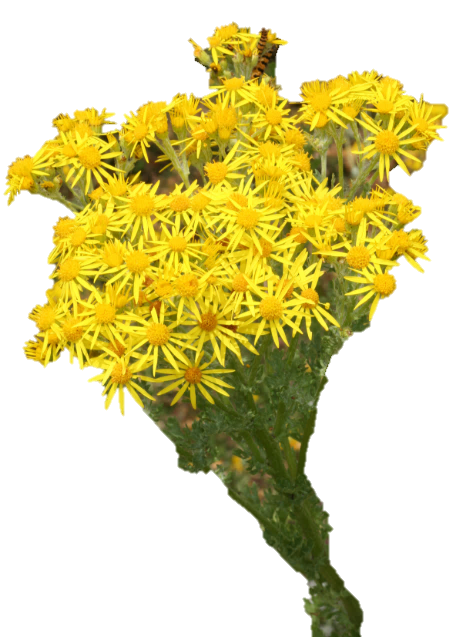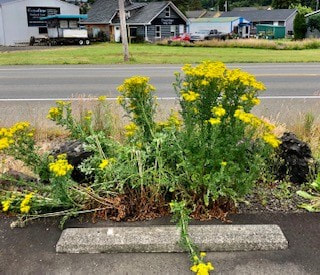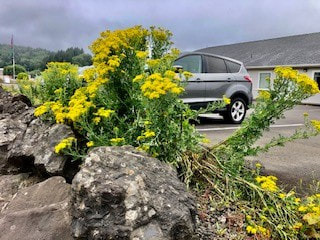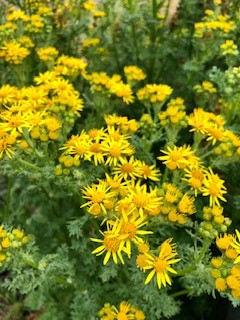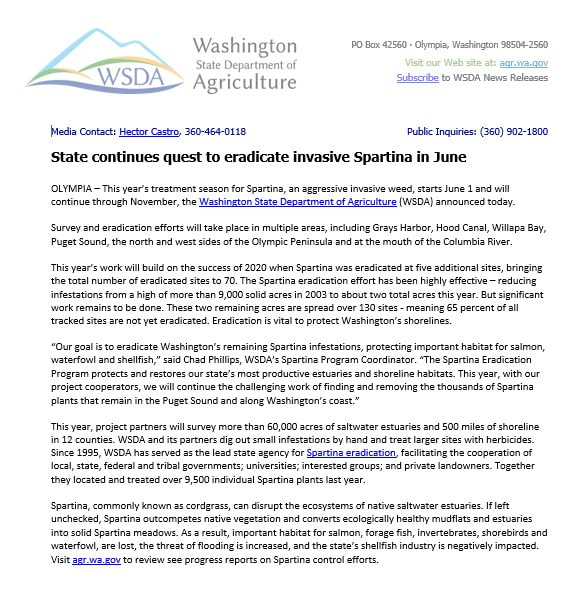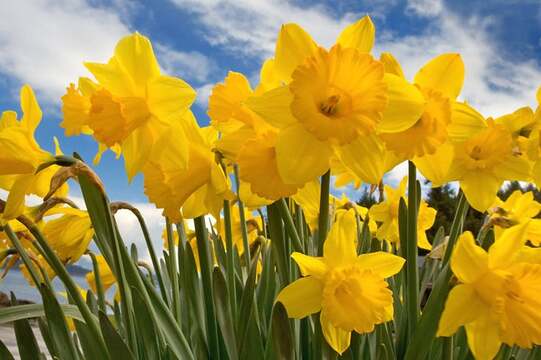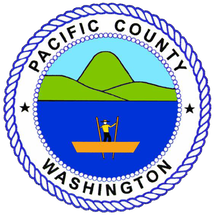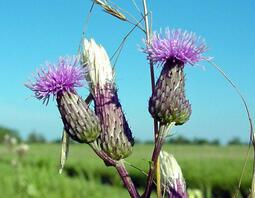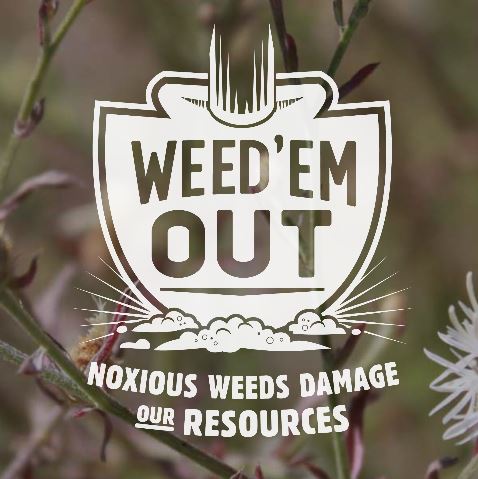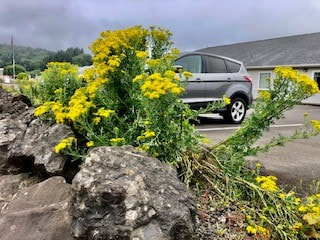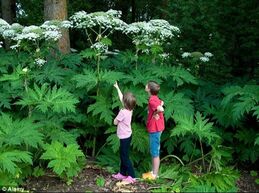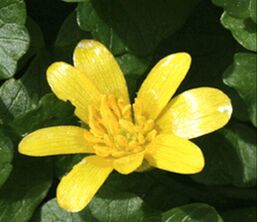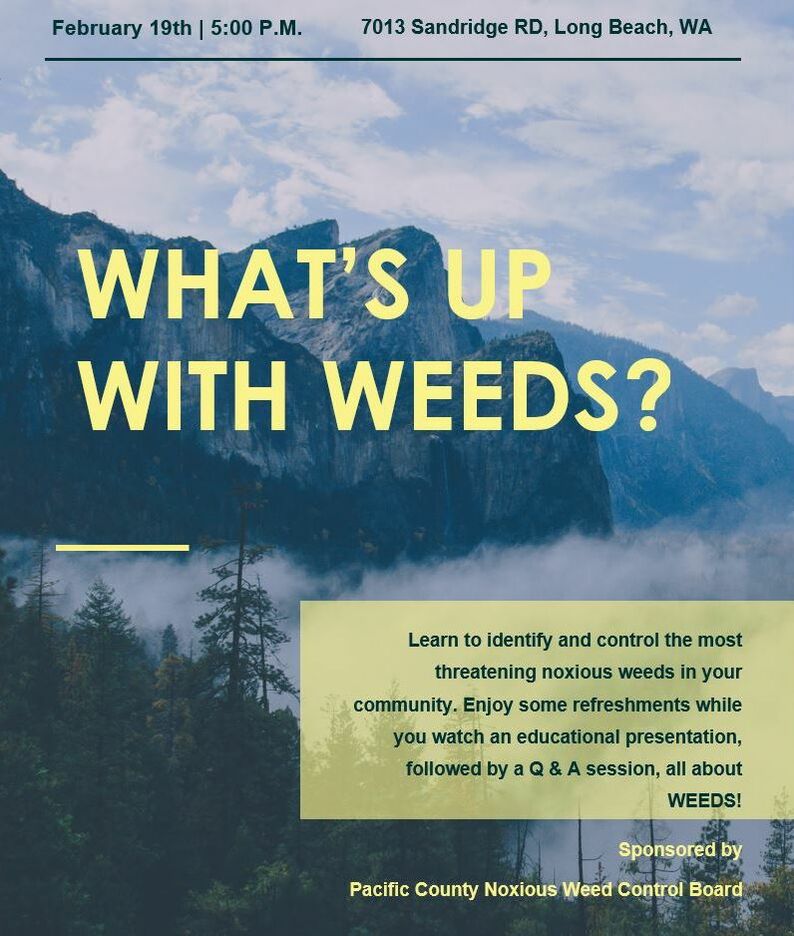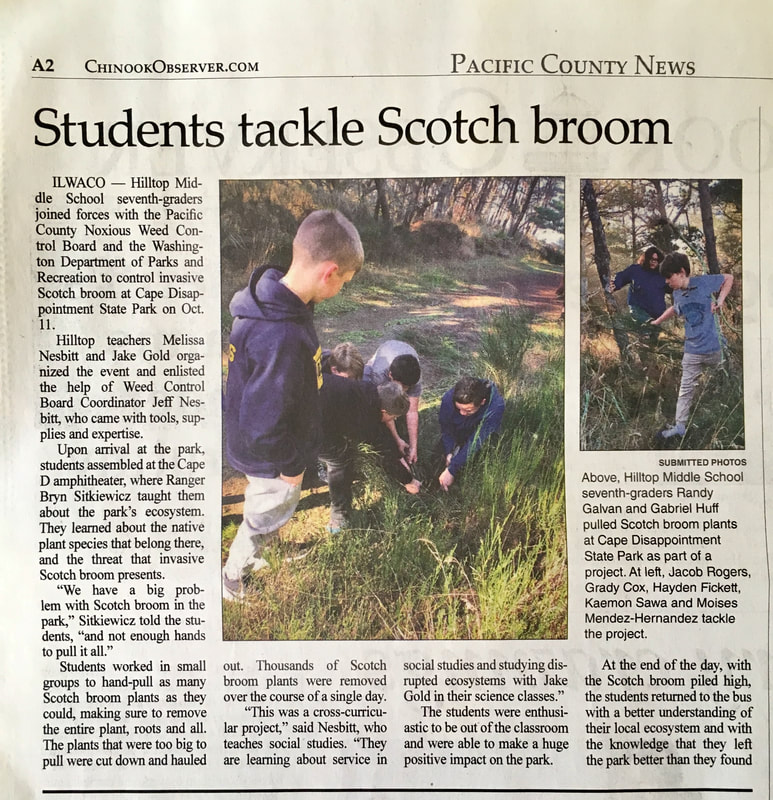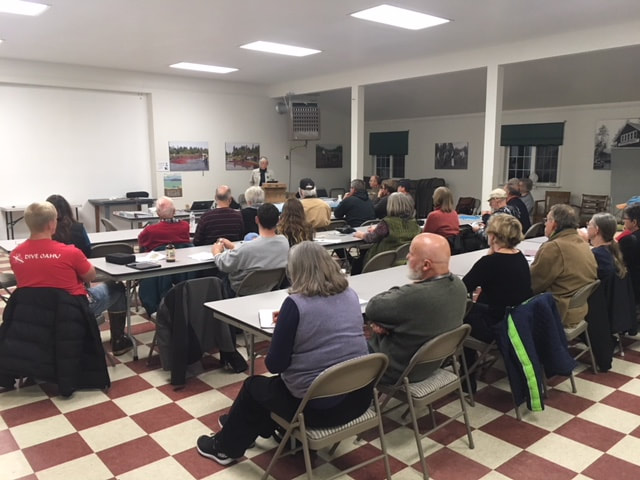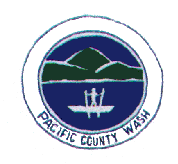Announcements & Events
CANCELED: Weed Board June Meeting
The June quarterly meeting of the Pacific County Noxious Weed Control Board is canceled and will not be rescheduled. The next meeting will take place on September 24, 2024.
ITS FINALLY HERE!!!
Tansy ragwort. Watch out for this deadly stuff June-October!
|
Have you noticed the bright yellow flowers appearing in shaggy clusters along Pacific County’s roads and in vacant lots in recent weeks? This plant is tansy ragwort (Jacobaea vulgaris), and it is not a nice plant. Tansy ragwort is highly toxic to humans and livestock. When ingested it can cause bloody diarrhea, liver failure, and a myriad of other unpleasant symptoms, including death. Alkaloids found throughout the plant are metabolized into more toxic forms by enzymes in the liver. These toxic metabolites accumulate and eventually cause irreversible damage, including cirrhosis and liver failure. Chronic and repeated exposure to these toxins poses the greatest risk. Tansy is a common problem in pastures and rangeland, where it easily outcompetes native vegetation and reduces available grazing acreage. Most animals will avoid grazing on fresh tansy in the field because it has a bitter taste. But when cut and dried, it retains its toxic properties and loses the bitterness. Tansy hidden in a hayfield can be easily harvested, sold, and served as animal feed before anybody is the wiser.
Tansy ragwort also poses a threat to humans as a contaminant in our food production system. A wide variety of products, including: milk, flour, and herbal remedies can become contaminated with tansy alkaloids during production and still make it to market. Several studies have even found that honey produced from the nectar of tansy ragwort flowers contains hazardous levels of the toxic alkaloids and should be considered a threat to human health. This is one of the reasons that pediatricians recommend not feeding honey to babies. |
To achieve long-term control, it is crucial that mature plants are eliminated from the population. A mature tansy ragwort plant can produce up-to a quarter-million seeds, which can remain viable in the soil for a decade or more.
Despite its wide distribution, tansy is relatively easy to control (compared to most other noxious weeds). All you need is a pair of gloves and some free time. Plants can easily be pulled-up, roots and all, by grabbing near the bottom of the stem and pulling up. Place the plants into plastic bags and dispose of them at your nearest solid waste facility. For larger infestations, the use of herbicide may be appropriate. Effective control can be achieved with products containing glyphosate, 2,4-D, and/or triclopyr (For more information regarding the use of herbicides, contact Pacific County Noxious Weed Control Board).
In Pacific County, landowners are required to control tansy ragwort identified on their property (17.10.140 RCW) and those who fail to do so may be issued a civil infraction and be required to pay an accompanying fine (WAC 16-750). The penalties are assessed per parcel, per noxious weed species, per day after expiration of the notice to control. If you have tansy ragwort on your property, get rid of it immediately. Do not wait for it to become a bigger problem than you are equipped to handle. Weed control projects can cost thousands of dollars, and that does not include any fines that you may have accrued for failure to control the noxious weeds.
Please share this information widely and take corrective action when and where you are able. Share what you know with the community. If your neighbor has tansy don’t get mad, talk to them about it! Many people see tansy every day and have no idea that it is a noxious weed. If you have any questions about the information presented here, or would like more information about tansy ragwort or other noxious weeds, contact the Pacific County Noxious Weed Control Board.
Thank you,
Jeff Nesbitt
Director
Pacific County Noxious Weed Control Board
Department of Vegetation Management
Despite its wide distribution, tansy is relatively easy to control (compared to most other noxious weeds). All you need is a pair of gloves and some free time. Plants can easily be pulled-up, roots and all, by grabbing near the bottom of the stem and pulling up. Place the plants into plastic bags and dispose of them at your nearest solid waste facility. For larger infestations, the use of herbicide may be appropriate. Effective control can be achieved with products containing glyphosate, 2,4-D, and/or triclopyr (For more information regarding the use of herbicides, contact Pacific County Noxious Weed Control Board).
In Pacific County, landowners are required to control tansy ragwort identified on their property (17.10.140 RCW) and those who fail to do so may be issued a civil infraction and be required to pay an accompanying fine (WAC 16-750). The penalties are assessed per parcel, per noxious weed species, per day after expiration of the notice to control. If you have tansy ragwort on your property, get rid of it immediately. Do not wait for it to become a bigger problem than you are equipped to handle. Weed control projects can cost thousands of dollars, and that does not include any fines that you may have accrued for failure to control the noxious weeds.
Please share this information widely and take corrective action when and where you are able. Share what you know with the community. If your neighbor has tansy don’t get mad, talk to them about it! Many people see tansy every day and have no idea that it is a noxious weed. If you have any questions about the information presented here, or would like more information about tansy ragwort or other noxious weeds, contact the Pacific County Noxious Weed Control Board.
Thank you,
Jeff Nesbitt
Director
Pacific County Noxious Weed Control Board
Department of Vegetation Management
Press Release 1.27.2022
Shoalwater Bay Indian Tribe and Pacific County Vegetation Management
Willapa Bay European Green Crab Trapping Efforts
Tokeland, Wa.-The European Green Crab (Carcinus maenas) is a small shore crab whose native distribution is in the northeast Atlantic Ocean and Baltic Sea, ranging along coasts from northern Africa to Norway and Iceland. Invasive to North America and responsible for threatening coastal fisheries on the East Coast, potential impacts by European Green Crab (EGC) in Willapa Bay include destruction of eelgrass beds and estuarine marsh habitats, threats to the harvest of wild shellfish and the shellfish aquaculture industry, the Dungeness crab fishery, salmon recovery, and a complex array of ecological impacts to food webs (WDFW, 2021). Historically WDFW documented EGC in the late 1990’s within Willapa Bay. Monitoring and trapping by WDFW ceased or didn’t detect EGC, until 2015 when Washington Sea Grant again monitored previous sites. Shoalwater Bay Indian Tribe became involved in 2020 with trapping and development of a Sentinel site for monitoring on Shoalwater Bay Tribal land.
When trapping first began in Tokeland, the expectation was that...
Full press release here
Willapa Bay European Green Crab Trapping Efforts
Tokeland, Wa.-The European Green Crab (Carcinus maenas) is a small shore crab whose native distribution is in the northeast Atlantic Ocean and Baltic Sea, ranging along coasts from northern Africa to Norway and Iceland. Invasive to North America and responsible for threatening coastal fisheries on the East Coast, potential impacts by European Green Crab (EGC) in Willapa Bay include destruction of eelgrass beds and estuarine marsh habitats, threats to the harvest of wild shellfish and the shellfish aquaculture industry, the Dungeness crab fishery, salmon recovery, and a complex array of ecological impacts to food webs (WDFW, 2021). Historically WDFW documented EGC in the late 1990’s within Willapa Bay. Monitoring and trapping by WDFW ceased or didn’t detect EGC, until 2015 when Washington Sea Grant again monitored previous sites. Shoalwater Bay Indian Tribe became involved in 2020 with trapping and development of a Sentinel site for monitoring on Shoalwater Bay Tribal land.
When trapping first began in Tokeland, the expectation was that...
Full press release here
Digging a few of the last remaining spartina plants from Willapa Bay (September 2021).
July 6th, 2021 Public Service Announcement
Tansy ragwort: Killer Weed
By Jeff Nesbitt
By Jeff Nesbitt
The bright yellow flower appearing along Pacific County’s roads, in abandoned lots, and on driveways is called Tansy ragwort (Jacobaea vulgaris), and it is not as nice as it looks. Tansy is highly toxic to humans and livestock, and when ingested can cause bloody diarrhea, liver failure, and a myriad of other unpleasant symptoms, including death. Alkaloids found in the flowers, leaves, stems, and roots are metabolized by enzymes in the liver into more toxic forms. These toxic metabolites accumulate and eventually cause irreversible damage, including cirrhosis and liver failure. Since the damage is cumulative, repeated exposure poses the greatest risk. Tansy is a common problem in pastures and rangeland, where it easily outcompetes native vegetation and reduces available grazing acreage. Most animals will avoid grazing on tansy in the field because it has a bitter taste. But when cut and dried, it retains its toxic properties and loses the bitterness. Tansy hidden in a hayfield can be easily harvested, dried, baled, sold, and served before anyone is the wiser, especially the hungry animals.
Tansy poses a threat to humans as a contaminant in our food production system, with long-term consumption being the greatest concern. A wide variety of products are susceptible to contamination during production, including: milk, flour, and herbal remedies. Several studies have even shown that bees foraging from tansy ragwort flowers will produce toxic honey, with levels of alkaloids high enough to threaten human health when consumed regularly over time. This is part of the reason that honey is not recommended for consumption by infants.
A mature tansy ragwort plant can produce 100,000 to 250,000 seeds, which can remain viable in the soil for a decade or more. For long-term control, it is crucial that mature plants are eliminated from the population. Tansy is relatively easy to control compared to most other noxious weeds. All you need is a pair of gloves and some free time. Plants can easily be pulled-up, roots and all, by grabbing near the bottom of the stem and pulling up. Place the plants into plastic bags and dispose of them at your nearest solid waste facility. For larger infestations, the use of herbicide may be appropriate. Effective control can be achieved with products containing glyphosate, 2,4-D, and/or triclopyr (For more information regarding the use of herbicides, contact Pacific County Noxious Weed Control Board).
The tansy ragwort issue will not go away and will certainly get worse unless we do something about it. If you have tansy ragwort on your property, get rid of it immediately. Do not wait for it to become a problem that you are not equipped to handle. A large-scale weed control project can cost thousands of dollars, and that does not include the fines that you may have to pay as a penalty for failure to meet your responsibilities as a landowner (i.e. RCW 17.10.140). Be a good steward of the land and keep it healthy. If your neighbor has tansy, don’t get mad, talk to them about it! Many people see it everyday and have no idea that it is a problem. Please share this information widely and take corrective action when and where you are able. If you have any questions about the information presented here, or would like more information about tansy ragwort or other noxious weeds, contact the Pacific County Noxious Weed Control Board director Jeff Nesbitt ([email protected]; PCweeds.org).
Tansy poses a threat to humans as a contaminant in our food production system, with long-term consumption being the greatest concern. A wide variety of products are susceptible to contamination during production, including: milk, flour, and herbal remedies. Several studies have even shown that bees foraging from tansy ragwort flowers will produce toxic honey, with levels of alkaloids high enough to threaten human health when consumed regularly over time. This is part of the reason that honey is not recommended for consumption by infants.
A mature tansy ragwort plant can produce 100,000 to 250,000 seeds, which can remain viable in the soil for a decade or more. For long-term control, it is crucial that mature plants are eliminated from the population. Tansy is relatively easy to control compared to most other noxious weeds. All you need is a pair of gloves and some free time. Plants can easily be pulled-up, roots and all, by grabbing near the bottom of the stem and pulling up. Place the plants into plastic bags and dispose of them at your nearest solid waste facility. For larger infestations, the use of herbicide may be appropriate. Effective control can be achieved with products containing glyphosate, 2,4-D, and/or triclopyr (For more information regarding the use of herbicides, contact Pacific County Noxious Weed Control Board).
The tansy ragwort issue will not go away and will certainly get worse unless we do something about it. If you have tansy ragwort on your property, get rid of it immediately. Do not wait for it to become a problem that you are not equipped to handle. A large-scale weed control project can cost thousands of dollars, and that does not include the fines that you may have to pay as a penalty for failure to meet your responsibilities as a landowner (i.e. RCW 17.10.140). Be a good steward of the land and keep it healthy. If your neighbor has tansy, don’t get mad, talk to them about it! Many people see it everyday and have no idea that it is a problem. Please share this information widely and take corrective action when and where you are able. If you have any questions about the information presented here, or would like more information about tansy ragwort or other noxious weeds, contact the Pacific County Noxious Weed Control Board director Jeff Nesbitt ([email protected]; PCweeds.org).
Spring May Be Here Sooner Than You Think. |
There is a certain order to things. Every year around this time, dark green shoots erupt from the earth, in the same spots from which they emerged in years prior. These little green flags flying in the breeze signal the start of a new year in the worlds of plants. Soon, the unmistakable message that spring is here will be blasted from the blazing yellow trumpets that sit atop those green stems. They are the daffodils; a beloved and welcome harbinger to the eruption of life and color that will soon follow.
As the daffodils wake from their hibernation, we should take a moment to appreciate their beauty and also to recognize that soon we will see an explosion of plant growth, and that, sadly, much of that growth will be in the form of invasive plants and noxious weeds. Unlike daffodils, noxious weeds are plants that will damage and can even destroy the ecosystem in which they are established. Invasive plants can be deemed “noxious weeds” for various reasons (e.g. animal toxicity, aggressive reproduction, threat to native species/agriculture, etc.), but all of them share the potential to cause harm to people, wildlife, or habitat in one form or another. |
Some of these noxious weeds are easy to spot because they are ugly, or they make you sneeze, or they are pokey. For example, gorse (Ulex Europaeus), a Class B noxious weed, is a hideous looking plant that anybody North of Ocean Park can tell you all about. Gorse is dangerous for multiple reasons (fire danger, habitat loss, property devaluation, physical injury) and you can tell that it is nasty stuff just by looking at it. (If you still aren’t sure, try touching it. You will regret it). Gorse has long spikes that will easily penetrate even the best pair of Carhartts. For these reasons, the Pacific County Noxious Weed Control Board has designated gorse as a “County-select” weed, making control efforts by property owners mandatory.
Sometimes the bad guys are not as easy to spot. Many of them are beautiful and people will transplant them in an attempt at cultivation in a garden or in landscaping. It is no surprise that these plants do not honor property boundaries, and without the presence of natural predation or competition, they thrive. Scotch Broom (Class B noxious weed) was allegedly introduced to Washington State during highway construction to provide a pleasant aesthetic and to prevent erosion along roadsides, both of which it does accomplish. However, after you account for the millions of tax-dollars spent to control it in subsequent decades, it is clear that somebody made a huge mistake. In 2017, an economic impact report regarding invasive species was produced in a collaborative effort by WSDA, Ecology, WSDOT, WA Invasive Species Council, and several other state agencies. The report concluded that Scotch broom and Spartina alterniflora alone could cost the state $191 million per year in potential lost revenue and over one thousand lost jobs statewide, if they are left unmanaged. In Pacific County, we have both of these weeds and many more. The full Noxious Weed List, which is updated annually, is available at PCweeds.org.
When the daffodils bloom in a few weeks, take a moment to be grateful that we get to be a part of this amazing web of life. And then take another moment to make your noxious weed control plans for the year. A little bit of planning goes a long way, and preventing a problem is always better than reacting to one. Don’t assume that your property is weed-free. Do your research. Make annual weed control part of your spring routine and you could save yourself (and your neighbors) massive amounts of time and money. Learn how to identify the weeds that you are most-likely to see, and how to manage them. The Pacific County Noxious Weed Control Board is ready and willing to provide expert advice, project planning assistance, equipment rentals and whatever else you need to get the job done. We are here to help. You can find more information at our website (PCweeds.org).
Sometimes the bad guys are not as easy to spot. Many of them are beautiful and people will transplant them in an attempt at cultivation in a garden or in landscaping. It is no surprise that these plants do not honor property boundaries, and without the presence of natural predation or competition, they thrive. Scotch Broom (Class B noxious weed) was allegedly introduced to Washington State during highway construction to provide a pleasant aesthetic and to prevent erosion along roadsides, both of which it does accomplish. However, after you account for the millions of tax-dollars spent to control it in subsequent decades, it is clear that somebody made a huge mistake. In 2017, an economic impact report regarding invasive species was produced in a collaborative effort by WSDA, Ecology, WSDOT, WA Invasive Species Council, and several other state agencies. The report concluded that Scotch broom and Spartina alterniflora alone could cost the state $191 million per year in potential lost revenue and over one thousand lost jobs statewide, if they are left unmanaged. In Pacific County, we have both of these weeds and many more. The full Noxious Weed List, which is updated annually, is available at PCweeds.org.
When the daffodils bloom in a few weeks, take a moment to be grateful that we get to be a part of this amazing web of life. And then take another moment to make your noxious weed control plans for the year. A little bit of planning goes a long way, and preventing a problem is always better than reacting to one. Don’t assume that your property is weed-free. Do your research. Make annual weed control part of your spring routine and you could save yourself (and your neighbors) massive amounts of time and money. Learn how to identify the weeds that you are most-likely to see, and how to manage them. The Pacific County Noxious Weed Control Board is ready and willing to provide expert advice, project planning assistance, equipment rentals and whatever else you need to get the job done. We are here to help. You can find more information at our website (PCweeds.org).
2020 Noxious Weed List Available Now!
The Pacific County Noxious Weed Control Board adopted the 2020 Noxious Weed List following a public hearing on January 8th. The complete list can be found HERE.
Do you have a weed problem? We can help.
Spring is just around the corner and the weeds are going to start popping up. It is time to plan your control work for the year, and we have what you need to get started.
Let's get out there and KILL SOME WEEDS!
Did you notice the Noxious weed fee on your property tax statement?
|
The Pacific County Noxious Weed Control Board has been funded via property tax assessment since 2019. The assessment funds help to ensure a robust noxious weed control program here in Pacific County. Thank you, Pacific County, for helping us to keep improving.
For more information please check out Frequently Asked Questions. If you still need more information, please email [email protected]. |
Hey Look... We Are Famous!
Full house for Noxious Weed Event!
|
On Wednesday February 7, interested citizens from across Pacific County gathered at the Cranberry Museum in Long Beach for Management Options for Invasive Weeds, presented by the Friends of the Willapa National Wildlife Refuge. Speakers Dr. Kim Patten (WSU Long Beach) and Jeff Nesbitt (Pacific County Noxious Weed Board) gave an informative presentation about local noxious weed threats and what people can do to combat them. The Pacific County Noxious Weed Control Board provided a great selection of useful educational materials, all of which are still available by request.
|
Questions, Comments? |
Office Location410 Quincy Street, South Bend, WA 98586
|
Telephone360-875-9425
|
|
